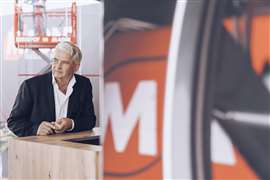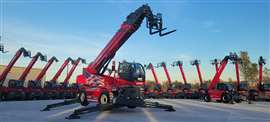Interview: why Riccardo Magni has high hopes for the future
12 December 2023
In 2016, Riccardo Magni sold 20% of the company he founded to Dingli, an up-and-coming Chinese OEM with goals to make a name for itself in Europe with a line of boom lifts designed by the Italian manfacturer. Since then, both companies have benefited from the partnership, however Magni regained full ownership last month in a move to take full advantage of growth opportunities. We sat down with Riccardo Magni to find out what’s new with the company’s machines, as well as his views on the future.
 Riccardo Magni, president and founder of Magni Telescopic Handlers
Riccardo Magni, president and founder of Magni Telescopic Handlers
These are exciting times for Magni Telescopic Handlers. The Italian OEM last week announced the enhancement of its RTH Series of rotating telehandlers during a dealer event at its US manufacturing plant in Texas, and announced it has regained full ownership of the company following the purchase of the 20% stake it sold to Dingli in 2016.
At the recent event, the company introduced new 8.35 and 8.46 rotating models. The 8.35 follows the redesign of the 6.36 model, with upgraded load charts and a boost in lifting capacity, which has been increased by 2 tonnes. The RTH 8.46 is the result of the restyling of the first-generation 6.46 model and provides a new boom allowing lifting capacities up to 8 tonnes (17,600 lbs.), which makes it the second largest in its class.
Magni currently offers RTH models ranging from 5 to 13 tons.
Press was given the opportunity to speak with Riccardo Magni, president and founder of the company, during the meeting in Texas. Magni spoke with pride about the company’s designs and innovations, as well as his views on the future of equipment and the rental market. Following is an excerpt from that discussion.
KHL: What is the primary difference in the new rotating telehandlers just introduced?
Magni: We substantially moved the cab forward. This provides a good view of the forks and also to the right side of the machine. And because these machines travel on the road in Europe, moving the cab forward puts the operator closer to the end of the boom, which is safer during transport.
We also have patented a very simple device that allows you to push a button and rotate.
We increased the very massive capacity of the machines because we completely redesigned the chassis and the boom, and we increased the ballast - the counterweight. We obtained with this stronger boom, stronger chassis and more ballast a much better load chart.
KHL: Where do things stand in your partnership with Dingli for the design of their lifts for the European market?
Magni: We bought back the 20% stake we sold to Dingli two weeks ago. I signed the agreement in China.
KHL: What led to this decision?
Magni: In 2017, [Dingli owner Xu Shugen] came to us and said he liked very much what we were doing, so we signed an agreement to design boom lifts for them. We designed 10 models. What
 Magni unveiled its enhanced line of rotating telehandlers during a dealer event at its US manufacturing plant in Texas.
Magni unveiled its enhanced line of rotating telehandlers during a dealer event at its US manufacturing plant in Texas.
they produce now is designed by me.
Besides that, [Shugen] told me he was interested in buying minority participation in our company.
At that time, for us it was a very, very big offer. He gave us €15 million for 20% of the company. We made an increase of capital for the company, and it helped us a lot at that time. Besides, he paid for the technology that we developed for Dingli, and we made an agreement with them to distribute the boom lifts (telescopic and articulated) in Europe, which is working well.
We have a very good relationship, even now. Dingli is also a family company, like ours. I asked him to sell me back my 20%. It took one year to discuss everything and he made a very good deal because now I’m paying €61.4 million for what he paid €15 million.
Now he has a fantastic range, is producing 5,000 units per year. He dedicated a big manufacturing site to this and is really very happy because we did a good job with the design of the machine that is very simple, very innovative.
KHL: How is the Magni boom lift design unique?
Magni: The machine design is completely different from what is on the market. My idea was to put the engine and everything on the chassis. I have some critics for this, but I lowered the center of gravity of the machine, giving us an advantage in performance.
We normally have 1,000-lb. capacity on the basket and we achieve very good reach without increasing the weight of the machine because of this layout. The lower center of gravity machine is much better for maintenance too. There are some patents on this.
KHL: Was that the incentive to buy back the 20% stake?
Magni: We had a very good collaboration with Dingli. In Europe, we are selling a very good volume. We go over €100 million in sales of the Dingli machine. Now we have an issue in that the European community has started the procedure to check Chinese companies for anti-dumping, like what happened in United States. It’s not very positive.
KHL: With the emphasis on alternative power in equipment right now, do you have plans for an electric rotating telehandler for your lineup?
Magni: We don’t see so much money in doing that. The costs are almost double over normal machines, time of use with the battery is very short - between three and four hours. And the power you need to recharge is very big. You need between 50 and 80 kilowatts of power, and so it’s not so usable on a jobsite.
We do have a solution that is very cheap and can solve the problem. We have an electric motor that we fit in the back of the machine, the Twin Power 400V. It plugs into the hydraulic system of [our rotating telehandler], which can be stationary on a jobsite for a month or more sometimes. When the machine doesn’t move, or in locations where you have no space, it can stay there and you can plug [the Twin Power 400V] into electricity. This module activates all the functions of the machine, it costs $15,000 to $18,000, so it’s not very expensive. So you have no battery to recharge, and the cost is very low.
You can move the module from one machine to another machine in an hour. There are many of these in Europe, but it’s new in the U.S.
KHL: Do you think electrification is the answer for powering construction equipment going forward?
Magni: I don’t think electricity is a final solution to all problems because now everything is electric but I don’t know where we will find all this electricity, especially as in Europe.
Hydrogen is under development, and this could be a solution because you get good power. The big problem is hydrogen doesn’t stay in the metal tank, it goes out through through the metal. You need to have a carbon fiber tank, which is very difficult to build for the hydrogen.
KHL: How do you see global rental demand going forward?
Magni: Europe will not be very good next year due to the costs of construction materials, and the cost of money. The interest rate is very high. We have the war still in Ukraine. That is disturbing us. We have now a war in Israel as well.
We are waiting for the end of the war in Ukraine, and I think this will give us some improvement because 80% of the country needs to be rebuilt.
Our budget for next year is flat. We think the economy will be good in the U.S. and we will even increase our revenue here in America. We are very happy that a big part of our revenue comes from the U.S.
MAGAZINE
NEWSLETTER
CONNECT WITH THE TEAM






